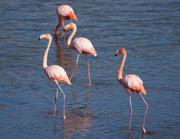| Wildlife |
Following the removal of Floreana's introduced mammalian invaders, many of the islands threatened endemic plant species are now flourishing. Unfortunately, this has brought with it the flourishing of some particularly unsavoury weeds. However, with the employment of local residents, substantial ongoing efforts have been made to control the spread of these weeds.
The involvement of local residents is of utmost importance throughout the development of Project Floreana. As guardians of the island, it is crucial that the locals are fully engaged with planning and decision making. The project aims to educate locals by encouraging sustainable living, focusing on waste management, water, energy and agricultural production. Investments will be made to help fund vocational training and education for local residents, in the hope that Floreana will provide an example to the rest of the archipelago and ultimately the world.
The reintroduction of several extinct endemic species is at the forefront of Project Floreana, with the removal of foreign invaders that contributed to their extinction in the first place. The Floreana mocking bird is the flagship of the Project, as it represents the fundamental link between Darwin and his theory of natural selection. It is estimated that there are now approximately 470 Floreana mocking birds in existence, dispersed between two small offshore islets. Although the population appears relatively stable, the limited distribution of the mockingbird makes this species highly vulnerable. Like the mockingbird, the Galapagos Racer Snake (Philodryas biserialis) can also only be found residing on these islets. Before the Floreana mockingbird and the racer snake can be reintroduced to the main island, careful planning and action needs to be adhered to, in particular the control and/or removal or invasive species, habitat restoration and reducing the threat of disease.
The presence of rats, mice and cats has been a significant problem on the island, in particular for the bird population of whose eggs are a prime target. Extensive work has been carried out to control these mammals, particularly around the petrel breeding areas, with the ultimate aim being a complete eradication.
The Floreana tortoise is believed to have become extinct in around 1850. However, scientists have since identified nine tortoises with apparent Floreana ancestry. The tortoises (6 females and 3 males) are currently housed at the Charles Darwin Research Station and are hoped to become part of a proposed breeding programme.
Puerto Velasco Ibarra was once a highly productive, thriving marine port, with an abundance of lobsters, groupers and other fish. In recent years, the area has become heavily overfished, resulting in dwindling fish populations. However, a recent proposal to protect a 4 km stretch of coastline, whilst allowing fishing to continue on the adjacent stretch, hopes to encourage a restoration process among such declining populations.
Floreana coral was once a thriving and bountiful species of the Galapagos Islands, however; the El Niño event of 1983 resulted in much of this beautiful species to be wiped out. Due to the unique biodiversity that exists in the Galapagos waters, such coral is valued and as a consequence, the region is protected by being designated a Marine Reserve and World Heritage Site. Floreana coral is included in the appendix of the Convention on International Trade in Endangered Species, meaning that the trade of it is carefully regulated; however, it is still at risk from natural disasters and climate change.
Photograph kindly provided by Ralph Pannell
The Beagle - Mary Anne - Cachalote - Sagitta - Amazonia - Samba - Beluga - Galaxy - Princess Grace - Aida Maria - Eden - Evolution - Eclipse - Grand Odyssey - Journey I - Eric - Flamingo - Letty - Odyssey - Athala - Nemo I - Nemo II - Diamante - Alta - Lammer Law - Rachel - La Pinta - Humboldt Explorer - Parranda - Isabela (Albemarie) - Santa Cruz (Indefatigable) - San Cristobal (Chatham) - Baltra (South Seymour) - North Seymour (Seymour Norte) - Fernandina (Narborough) - Española (Hood) - Genovesa (Tower) - Bartolomé (Bartolemew) - Santiago (San Salvador or James) - Santa María (Floreana or Charles) - Marchena (Blindoe) - Mosquera - Plaza Sur (South Plaza) - Pinta (Abingdon) - Pinzón (Duncan) - Santa Fé (Barrington) - Rabida (Jervis) - Daphne
Galapagos wildlife birdlife birdwatching & natural history holidays - Sail Galapagos islands - expedition cruise vacation holiday - Ecuador responsible travel - Amazon - Andes - Quito - Guayaquil - sky aggressor - Dive Snorkel Diving & Snorkelling - kayak westsuit - Latin & South America journey - Specialist Guided Photography holidays workshops - Charles Darwin Research Station - Galapagos Conservation Trust - Rainforest Concern




